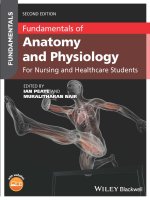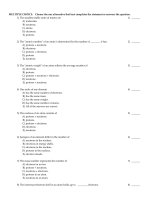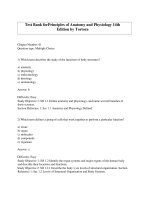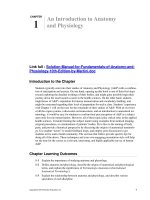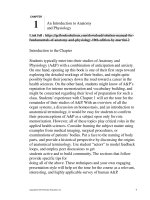Test bank for fundamentals of anatomy and physiology 11e c18
Bạn đang xem bản rút gọn của tài liệu. Xem và tải ngay bản đầy đủ của tài liệu tại đây (422.88 KB, 43 trang )
Chapterȱ18 TheȱEndocrineȱSystem
Multiple Choice Questions
1) Whichȱofȱtheȱfollowingȱisȱtrue ofȱtheȱendocrineȱsystem?
A) Itȱrespondsȱrapidlyȱtoȱstimuli.
B) Itȱrespondsȱspecificallyȱtoȱdigestiveȱstimuli.
C) Itȱcommunicatesȱbyȱtheȱreleaseȱofȱneurotransmitters.
D) Itȱrespondsȱwithȱmotorȱoutput.
E) Itȱrespondsȱslowlyȱbutȱeffectivelyȱforȱmaintainingȱhomeostaticȱfunctions.
Answer: E
LearningȱOutcome: 18-1
BloomȇsȱTaxonomy: Remembering
2) Endocrineȱcells
A) areȱaȱtypeȱofȱnerveȱcell.
B) releaseȱtheirȱsecretionsȱontoȱanȱepithelialȱsurface.
C) releaseȱtheirȱsecretionsȱdirectlyȱintoȱbodyȱfluidsȱsuchȱasȱblood.
D) containȱfewȱvesicles.
E) areȱmodifiedȱconnectiveȱtissueȱcells.
Answer: C
LearningȱOutcome: 18-1
BloomȇsȱTaxonomy: Remembering
3) ________ȱareȱchemicalȱmessengersȱthatȱareȱreleasedȱbyȱcellsȱandȱtransportedȱinȱthe
bloodstreamȱtoȱalterȱtheȱactivitiesȱofȱspecificȱcellsȱinȱotherȱtissues.
A) Hormones
B) Neuropeptides
C) Neurotransmitters
D) Humoralȱantibodies
E) Antigens
Answer: A
LearningȱOutcome: 18-1
BloomȇsȱTaxonomy: Remembering
4) Aȱhormoneȱmight
A) alterȱaȱmembraneȱchannelȱbyȱchangingȱitsȱshape,ȱtherebyȱaffectingȱwhatȱcanȱgoȱthrough
it.
B) depolarizeȱaȱskeletalȱmuscleȱcell.
C) interfereȱwithȱnorepinephrineȱatȱaȱneuronalȱsynapse.
D) inactivateȱglucoseȱsoȱitȱcannotȱbeȱusedȱbyȱaȱcell.
E) blockȱtheȱproductionȱofȱaȱcellȱmembrane.
Answer: A
LearningȱOutcome: 18-1
BloomȇsȱTaxonomy: Understanding
Copyrightȱ©ȱ2018ȱPearsonȱEducation,ȱInc.
576ȱȱȱTestȱBankȱforȱFundamentalsȱofȱAnatomyȱ&ȱPhysiology,ȱ11e
5) Whichȱofȱtheȱfollowingȱisȱnotȱtrueȱregardingȱtargetȱcells?
A) Theyȱhaveȱreceptorsȱforȱaȱspecificȱhormone.
B) Theyȱcanȱbeȱanywhereȱinȱtheȱbody.
C) Theyȱareȱassociatedȱwithȱsynapses.
D) Theyȱcanȱrespondȱtoȱmoreȱthanȱoneȱhormoneȱifȱtheyȱhaveȱreceptorsȱforȱeachȱone.
E) Ifȱaȱtargetȱcellȱlacksȱreceptorsȱforȱaȱhormoneȱthenȱitȱcannotȱbindȱthatȱhormone.
Answer: C
LearningȱOutcome: 18-1
BloomȇsȱTaxonomy: Understanding
6) HormonesȱknownȱasȱȈcatecholaminesȈȱare
A) lipids.
B) peptides.
C) steroids.
D) derivativesȱofȱtheȱaminoȱacidȱtyrosine.
E) derivativesȱofȱreproductiveȱglands.
Answer: D
LearningȱOutcome: 18-2
BloomȇsȱTaxonomy: Remembering
7) Peptideȱhormonesȱare
A) composedȱofȱaminoȱacids.
B) producedȱbyȱtheȱadrenalȱglands.
C) derivedȱfromȱtheȱaminoȱacidȱtyrosine.
D) lipids.
E) chemicallyȱrelatedȱtoȱcholesterol.
Answer: A
LearningȱOutcome: 18-2
BloomȇsȱTaxonomy: Remembering
8) Aȱkinaseȱisȱanȱenzymeȱthatȱperforms
A) phosphorylation.
B) asȱaȱmembraneȱchannel.
C) activeȱtransport.
D) proteinȱsynthesis.
E) asȱanȱantibody.
Answer: A
LearningȱOutcome: 18-2
BloomȇsȱTaxonomy: Understanding
9) Calciumȱionsȱserveȱasȱmessengers,ȱoftenȱinȱcombinationȱwithȱtheȱintracellularȱprotein
A) calcitonin.
B) calcitriol.
C) calmodulin.
D) calcium-bindingȱglobulin.
E) calcitropin.
Answer: C
LearningȱOutcome: 18-2
BloomȇsȱTaxonomy: Understanding
Copyrightȱ©ȱ2018ȱPearsonȱEducation,ȱInc.
Chapterȱ18ȱȱTheȱEndocrineȱSystemȱȱȱ577
10) Whichȱofȱtheȱfollowingȱsubstancesȱactivatesȱproteinȱkinasesȱandȱthusȱactsȱasȱaȱsecond
messenger?
A) insulin
B) ACTH
C) epinephrine
D) cyclicȱAMP
E) TSH
Answer: D
LearningȱOutcome: 18-2
BloomȇsȱTaxonomy: Understanding
11) Allȱofȱtheȱfollowingȱareȱtrueȱofȱsteroidȱhormonesȱexcept thatȱthey
A) areȱproducedȱbyȱtheȱadrenalȱmedulla.
B) areȱderivedȱfromȱcholesterol.
C) areȱproducedȱbyȱreproductiveȱglands.
D) bindȱtoȱreceptorsȱwithinȱtheȱcell.
E) areȱlipids.
Answer: A
LearningȱOutcome: 18-2
BloomȇsȱTaxonomy: Remembering
12) Eachȱofȱtheȱfollowingȱhormonesȱisȱanȱaminoȱacidȱderivativeȱexcept
A) epinephrine.
B) norepinephrine.
C) thyroidȱhormone.
D) testosterone.
E) melatonin.
Answer: D
LearningȱOutcome: 18-2
BloomȇsȱTaxonomy: Remembering
13) Membraneȱreceptorsȱareȱusedȱbyȱwhichȱofȱtheȱfollowingȱtypesȱofȱhormones?
A) catecholamines
B) peptideȱhormones
C) eicosanoids
D) thyroid
E) catecholamines,ȱpeptideȱhormones,ȱandȱeicosanoids
Answer: E
LearningȱOutcome: 18-2
BloomȇsȱTaxonomy: Understanding
14) Steroidȱhormones
A) areȱproteins.
B) cannotȱdiffuseȱthroughȱcellȱmembranes.
C) bindȱtoȱreceptorsȱinȱtheȱnucleusȱofȱtheirȱtargetȱcells.
D) actȱonȱtargetȱcellsȱbyȱactivatingȱsecondȱmessengerȱcascades.
E) areȱtransportedȱinȱtheȱbloodȱdissolvedȱinȱtheȱplasma.
Answer: C
LearningȱOutcome: 18-2
BloomȇsȱTaxonomy: Remembering
Copyrightȱ©ȱ2018ȱPearsonȱEducation,ȱInc.
578ȱȱȱTestȱBankȱforȱFundamentalsȱofȱAnatomyȱ&ȱPhysiology,ȱ11e
15) Whenȱaȱcatecholamineȱorȱpeptideȱhormoneȱbindsȱtoȱreceptorsȱonȱtheȱsurfaceȱofȱaȱcell,ȱthe
A) hormoneȱreceptorȱcomplexȱmovesȱintoȱtheȱcytoplasm.
B) cellȱmembraneȱbecomesȱdepolarized.
C) secondȱmessengerȱappearsȱinȱtheȱcytoplasm.
D) cellȱbecomesȱinactive.
E) hormoneȱisȱtransportedȱtoȱtheȱnucleusȱwhereȱitȱaltersȱtheȱactivityȱofȱDNA.
Answer: C
LearningȱOutcome: 18-2
BloomȇsȱTaxonomy: Remembering
16) Hormonesȱcanȱbeȱdividedȱintoȱdifferentȱgroupsȱbasedȱonȱtheirȱchemistry.ȱTheseȱcategories
includeȱallȱofȱtheȱfollowingȱexcept
A) peptides.
B) steroids.
C) eicosanoids.
D) aminoȱacidȱderivatives.
E) acetylcholineȱderivatives.
Answer: E
LearningȱOutcome: 18-2
BloomȇsȱTaxonomy: Remembering
17) Hormonalȱactionsȱonȱcellsȱaffectȱallȱofȱtheȱfollowingȱexcept
A) quantitiesȱofȱenzymes.
B) activitiesȱofȱenzymes.
C) synthesisȱofȱenzymes.
D) gatingȱofȱionȱchannels.
E) thicknessȱofȱtheȱplasmaȱmembrane.
Answer: E
LearningȱOutcome: 18-2
BloomȇsȱTaxonomy: Understanding
18) Theȱlinkȱbetweenȱaȱfirstȱmessengerȱandȱaȱsecondȱmessengerȱinȱaȱcellȱthatȱrespondsȱtoȱpeptide
hormonesȱisȱusually
A) cAMP.
B) cGMP.
C) adenylȱcyclase.
D) aȱGȱprotein.
E) calciumȱionȱlevels.
Answer: D
LearningȱOutcome: 18-2
BloomȇsȱTaxonomy: Remembering
Copyrightȱ©ȱ2018ȱPearsonȱEducation,ȱInc.
Chapterȱ18ȱȱTheȱEndocrineȱSystemȱȱȱ579
19) Whenȱadenylȱcyclaseȱisȱactivated,
A) ATPȱisȱconsumed.
B) cAMPȱisȱformed.
C) cAMPȱisȱbrokenȱdown.
D) ATPȱisȱproduced.
E) ATPȱisȱconsumedȱandȱcAMPȱisȱformed.
Answer: E
LearningȱOutcome: 18-2
BloomȇsȱTaxonomy: Remembering
20) Afterȱaȱsteroidȱhormoneȱbindsȱtoȱitsȱreceptorȱtoȱformȱanȱactiveȱcomplex,
A) adenylȱcyclaseȱisȱactivated.
B) cyclicȱnucleotidesȱareȱformed.
C) Gȱproteinsȱareȱphosphylated.
D) geneȱtranscriptionȱisȱinitiated.
E) proteinȱkinasesȱareȱactivated.
Answer: D
LearningȱOutcome: 18-2
BloomȇsȱTaxonomy: Understanding
21) Theȱhumoralȱcontrolȱofȱhormoneȱreleaseȱmayȱbeȱtriggeredȱwhichȱofȱtheȱfollowingȱfactors?
A) bloodȱlevelȱofȱanȱionȱlikeȱcalcium
B) bloodȱlevelȱofȱaȱpituitaryȱhormone
C) bloodȱlevelȱofȱaȱhypothalamicȱhormone
D) nervousȱstimuli
E) neurotransmitterȱactivation
Answer: A
LearningȱOutcome: 18-2
BloomȇsȱTaxonomy: Understanding
22) Whichȱofȱtheȱfollowingȱhormonesȱis/areȱwaterȱsolubleȱandȱthereforeȱbind(s)ȱtoȱextracellular
receptors?
A) insulin
B) epinephrine
C) cortisol
D) calcitriol
E) insulinȱandȱepinephrine
Answer: E
LearningȱOutcome: 18-2
BloomȇsȱTaxonomy: Understanding
Copyrightȱ©ȱ2018ȱPearsonȱEducation,ȱInc.
580ȱȱȱTestȱBankȱforȱFundamentalsȱofȱAnatomyȱ&ȱPhysiology,ȱ11e
23) Ifȱtheȱadenylȱcyclaseȱactivityȱofȱliverȱcellsȱwereȱmissing,ȱwhichȱofȱtheseȱhormonesȱcouldȱno
longerȱstimulateȱreleaseȱofȱglucose?
A) progesterone
B) glucagon
C) cortisol
D) thyroxine
E) leptin
Answer: B
LearningȱOutcome: 18-2
BloomȇsȱTaxonomy: Understanding
24) Increasedȱactivityȱofȱphosphodiesteraseȱinȱaȱtargetȱcellȱwouldȱdecreaseȱitsȱlevelȱof
A) testosterone.
B) estrogen.
C) thyroidȱhormone.
D) cAMP.
E) progesterone.
Answer: D
LearningȱOutcome: 18-2
BloomȇsȱTaxonomy: Understanding
25) Theȱintracellularȱproteinȱ________ȱbindsȱcalciumȱion.ȱThisȱcomplexȱcanȱthenȱactivateȱenzymes.
A) prostaglandin
B) phosphodiesterase
C) cyclicȱAMP
D) calmodulin
E) kinase
Answer: D
LearningȱOutcome: 18-2
BloomȇsȱTaxonomy: Remembering
26) Receptorsȱforȱ________,ȱpeptideȱhormones,ȱandȱeicosanoidsȱareȱfoundȱinȱtheȱcellȱmembranesȱof
targetȱcells.
A) catecholamines
B) carbohydrates
C) kinases
D) genes
E) acetylcholine
Answer: A
LearningȱOutcome: 18-2
BloomȇsȱTaxonomy: Understanding
Copyrightȱ©ȱ2018ȱPearsonȱEducation,ȱInc.
Chapterȱ18ȱȱTheȱEndocrineȱSystemȱȱȱ581
27) Cellsȱthatȱrespondȱtoȱaȱhormoneȱareȱcalledȱ________ȱcells.
A) stem
B) pluripotent
C) germ
D) target
E) peripheral
Answer: D
LearningȱOutcome: 18-2
BloomȇsȱTaxonomy: Remembering
28) Oneȱcauseȱforȱinsulinȱresistanceȱinȱnon-insulinȱdependentȱ(TypeȱII)ȱdiabetesȱis
A) insulinȱreceptorȱup-regulation.
B) decreasedȱinsulinȱsecretion.
C) decreasedȱcortisolȱsecretion.
D) insulinȱreceptorȱdown-regulation.
E) cortisolȱreceptorȱup-regulation.
Answer: D
LearningȱOutcome: 18-2
BloomȇsȱTaxonomy: Applying
29) Whichȱofȱtheȱfollowingȱisȱnotȱaȱcharacteristicȱofȱtheȱsecond-messengerȱmechanismȱofȱhormone
action?
A) Hormoneȱeffectsȱareȱamplified.
B) GȱproteinsȱandȱcAMPȱareȱused.
C) Receptorsȱareȱonȱtheȱcellȱsurface.
D) Cellularȱoperationsȱareȱalteredȱbyȱdirectȱstimulationȱofȱaȱgene.
E) Kinasesȱmayȱphosphorylateȱproteins.
Answer: D
LearningȱOutcome: 18-2
BloomȇsȱTaxonomy: Understanding
30) Uponȱbindingȱofȱaȱsingleȱfirstȱmessengerȱtoȱaȱplasmaȱmembrane,ȱthousandsȱofȱsecond
messengersȱmayȱbecomeȱactivated.ȱThisȱeffectȱisȱknownȱas
A) receptorȱdown-regulation.
B) receptorȱup-regulation.
C) amplification.
D) humoralȱstimuli.
E) synergism.
Answer: C
LearningȱOutcome: 18-2
BloomȇsȱTaxonomy: Remembering
Copyrightȱ©ȱ2018ȱPearsonȱEducation,ȱInc.
582ȱȱȱTestȱBankȱforȱFundamentalsȱofȱAnatomyȱ&ȱPhysiology,ȱ11e
31) Intracellularȱcalciumȱstoresȱopenȱinȱresponseȱtoȱintracellularȱactivationȱof
A) proteinȱkinaseȱC,ȱdiacylglycerol,ȱandȱinositolȱtriphosphate.
B) calmodulin.
C) leukotrienes.
D) adenylateȱcyclase.
E) phosphodiesterase,ȱadenylateȱcyclase,ȱandȱprostacyclins.
Answer: A
LearningȱOutcome: 18-2
BloomȇsȱTaxonomy: Remembering
32) Leukotrienes,ȱprostaglandins,ȱandȱthromboxanesȱareȱallȱexamplesȱof
A) aminoȱacidȱderivatives.
B) eicosanoids.
C) tyrosineȱderivatives.
D) glycoproteins.
E) steroidȱhormones.
Answer: B
LearningȱOutcome: 18-2
BloomȇsȱTaxonomy: Remembering
33) Whichȱhormoneȱisȱnotȱcorrectlyȱmatched?
A) epinephrine:ȱaminoȱacidȱderivative
B) insulin:ȱpeptideȱhormone
C) testosterone:ȱaminoȱacidȱderivative
D) cortisol:ȱlipidȱderivative
E) eicosanoids:ȱlipidȱderivative
Answer: C
LearningȱOutcome: 18-2
BloomȇsȱTaxonomy: Remembering
34) Theȱhypothalamusȱactsȱasȱbothȱaȱneuralȱandȱa(n)ȱ________ȱorgan.
A) endocrine
B) cardiovascular
C) renal
D) muscular
E) hepatic
Answer: A
LearningȱOutcome: 18-3
BloomȇsȱTaxonomy: Understanding
35) Theȱmostȱcomplexȱendocrineȱresponsesȱinvolveȱthe
A) thyroidȱgland.
B) pancreas.
C) adrenalȱglands.
D) hypothalamus.
E) thymusȱgland.
Answer: D
LearningȱOutcome: 18-3
BloomȇsȱTaxonomy: Understanding
Copyrightȱ©ȱ2018ȱPearsonȱEducation,ȱInc.
Chapterȱ18ȱȱTheȱEndocrineȱSystemȱȱȱ583
36) Destructionȱofȱtheȱsupra-opticȱnucleusȱofȱtheȱhypothalamusȱwouldȱhaveȱwhichȱofȱthe
followingȱresults?
A) lossȱofȱADHȱsecretion
B) lossȱofȱGHȱsecretion
C) lossȱofȱmelatoninȱsecretion
D) lossȱofȱthyroidȱstimulatingȱhormoneȱsecretion
E) lossȱofȱprolactinȱsecretion
Answer: A
LearningȱOutcome: 18-3
BloomȇsȱTaxonomy: Understanding
37) Ifȱtheȱhypophysealȱportalȱsystemȱisȱdestroyed,ȱtheȱhypothalamusȱwouldȱnoȱlongerȱbeȱableȱto
controlȱtheȱsecretionȱofȱwhichȱofȱtheȱfollowingȱhormones?
A) TSH
B) ACTH
C) PRL
D) ADHȱandȱOXT
E) TSH,ȱACTH,ȱPRL
Answer: E
LearningȱOutcome: 18-3
BloomȇsȱTaxonomy: Understanding
38) Changesȱinȱbloodȱosmoticȱpressureȱwouldȱmostȱaffectȱtheȱsecretionȱof
A) ACTH.
B) ADH.
C) oxytocin.
D) TSH.
E) LH.
Answer: B
LearningȱOutcome: 18-3
BloomȇsȱTaxonomy: Remembering
39) Theȱhypothalamusȱcontrolsȱsecretionȱinȱtheȱadenohypophysisȱby
A) directȱneuralȱstimulation.
B) indirectȱosmoticȱcontrol.
C) secretingȱreleasingȱandȱinhibitingȱhormonesȱintoȱtheȱhypophysealportalȱsystem.
D) alteringȱionȱconcentrationsȱandȱpHȱinȱtheȱanteriorȱpituitary.
E) gapȱsynapticȱjunctions.
Answer: C
LearningȱOutcome: 18-3
BloomȇsȱTaxonomy: Understanding
Copyrightȱ©ȱ2018ȱPearsonȱEducation,ȱInc.
584ȱȱȱTestȱBankȱforȱFundamentalsȱofȱAnatomyȱ&ȱPhysiology,ȱ11e
40) Neuronsȱofȱtheȱsupra-opticȱandȱparaventricularȱnucleiȱofȱtheȱhypothalamusȱmanufacture
A) CRFȱandȱGnRH.
B) TSHȱandȱFSH.
C) ADHȱandȱoxytocin.
D) FSHȱandȱPRL.
E) GHIHȱandȱGHRH.
Answer: C
LearningȱOutcome: 18-3
BloomȇsȱTaxonomy: Remembering
41) Theȱmainȱactionȱofȱantidiureticȱhormoneȱis
A) increasedȱwaterȱconservationȱbyȱkidneys.
B) toȱstimulateȱkidneyȱcellsȱtoȱsecreteȱrenin.
C) increaseȱurineȱoutputȱtoȱremoveȱexcessȱfluid.
D) increasedȱbloodȱpressureȱbyȱincreasedȱNa+ reabsorption.
E) inhibitionȱofȱaldosterone.
Answer: A
LearningȱOutcome: 18-3
BloomȇsȱTaxonomy: Understanding
42) Excessȱsecretionȱofȱgrowthȱhormoneȱduringȱearlyȱdevelopmentȱwillȱcause
A) dwarfism.
B) rickets.
C) gigantism.
D) acromegaly.
E) diabetesȱinsipidus.
Answer: C
LearningȱOutcome: 18-3
BloomȇsȱTaxonomy: Remembering
43) Whichȱofȱtheȱfollowingȱhormonesȱmayȱleadȱtoȱacromegalyȱifȱhypersecretedȱafterȱclosureȱofȱthe
epiphysealȱplates?
A) cortisol
B) parathyroidȱhormone
C) insulin
D) growthȱhormone
E) epinephrine
Answer: D
LearningȱOutcome: 18-3
BloomȇsȱTaxonomy: Applying
Copyrightȱ©ȱ2018ȱPearsonȱEducation,ȱInc.
Chapterȱ18ȱȱTheȱEndocrineȱSystemȱȱȱ585
44) Theȱhormoneȱproducedȱbyȱtheȱparsȱintermediaȱofȱtheȱadenohypophysisȱduringȱearly
childhoodȱis
A) FSH.
B) ADH.
C) TSH.
D) MSH.
E) ACTH.
Answer: D
LearningȱOutcome: 18-3
BloomȇsȱTaxonomy: Remembering
45) Eachȱofȱtheȱfollowingȱhormonesȱisȱproducedȱbyȱtheȱparsȱdistalisȱofȱtheȱadenohypophysis
except
A) FSH.
B) oxytocin.
C) TSH.
D) corticotropin.
E) somatotropin.
Answer: B
LearningȱOutcome: 18-3
BloomȇsȱTaxonomy: Remembering
46) Allȱofȱtheȱfollowingȱareȱtrueȱofȱoxytocinȱexcept?
A) Itȱpromotesȱuterineȱcontractions.
B) Itȱisȱresponsibleȱforȱmilkȱexpressionȱfromȱtheȱmammaryȱglands.
C) Itȱtriggersȱprostateȱglandȱcontraction.
D) Itȱisȱproducedȱinȱtheȱhypothalamus.
E) Itȱisȱstoredȱinȱtheȱanteriorȱpituitary.
Answer: E
LearningȱOutcome: 18-3
BloomȇsȱTaxonomy: Understanding
47) Growthȱhormoneȱdoesȱallȱofȱtheȱfollowingȱexcept
A) promoteȱboneȱgrowth.
B) promoteȱmuscleȱgrowth.
C) promoteȱcortisolȱrelease.
D) spareȱglucose.
E) promoteȱaminoȱacidȱuptakeȱbyȱcells.
Answer: C
LearningȱOutcome: 18-3
BloomȇsȱTaxonomy: Remembering
Copyrightȱ©ȱ2018ȱPearsonȱEducation,ȱInc.
586ȱȱȱTestȱBankȱforȱFundamentalsȱofȱAnatomyȱ&ȱPhysiology,ȱ11e
48) Liverȱcellsȱrespondȱtoȱgrowthȱhormoneȱbyȱreleasingȱhormonesȱcalled
A) gonadotrophins.
B) prostaglandins.
C) hepaticȱhormones.
D) somatomedins.
E) glucocorticoids.
Answer: D
LearningȱOutcome: 18-3
BloomȇsȱTaxonomy: Remembering
49) Theȱpituitaryȱhormoneȱthatȱtriggersȱtheȱreleaseȱofȱthyroidȱhormoneȱfromȱtheȱthyroidȱglandȱis
A) TSH.
B) ACTH.
C) FSH.
D) LH.
E) GH.
Answer: A
LearningȱOutcome: 18-3
BloomȇsȱTaxonomy: Remembering
50) Theȱpituitaryȱhormoneȱthatȱcontrolsȱtheȱreleaseȱofȱglucocorticoidsȱfromȱtheȱadrenalȱcortexȱis
A) TSH.
B) ACTH.
C) FSH.
D) LH.
E) GH.
Answer: B
LearningȱOutcome: 18-3
BloomȇsȱTaxonomy: Remembering
51) Theȱpituitaryȱhormoneȱthatȱpromotesȱeggȱdevelopmentȱinȱovariesȱandȱspermȱdevelopmentȱin
testesȱis
A) TSH.
B) ACTH.
C) FSH.
D) LH.
E) GH.
Answer: C
LearningȱOutcome: 18-3
BloomȇsȱTaxonomy: Remembering
Copyrightȱ©ȱ2018ȱPearsonȱEducation,ȱInc.
Chapterȱ18ȱȱTheȱEndocrineȱSystemȱȱȱ587
52) Theȱpituitaryȱhormoneȱthatȱpromotesȱovarianȱsecretionȱofȱprogesteroneȱandȱtesticular
secretionȱofȱtestosteroneȱis
A) TSH.
B) ACTH.
C) FSH.
D) LH.
E) GH.
Answer: D
LearningȱOutcome: 18-3
BloomȇsȱTaxonomy: Remembering
53) Theȱpituitaryȱhormoneȱthatȱstimulatesȱmilkȱproductionȱbyȱtheȱmammaryȱglandsȱis
A) TSH.
B) ACTH.
C) growthȱhormone.
D) FSH.
E) prolactin.
Answer: E
LearningȱOutcome: 18-3
BloomȇsȱTaxonomy: Remembering
54) Theȱpituitaryȱhormoneȱthatȱstimulatesȱcellȱgrowthȱandȱreplicationȱbyȱacceleratingȱprotein
synthesisȱis
A) ACTH.
B) MSH.
C) prolactin.
D) insulin.
E) growthȱhormone.
Answer: E
LearningȱOutcome: 18-3
BloomȇsȱTaxonomy: Remembering
55) Afterȱbrainȱsurgery,ȱaȱpatientȱreceivingȱpostoperativeȱcareȱinȱanȱintensiveȱcareȱunitȱbeganȱto
passȱlargeȱvolumesȱofȱveryȱdiluteȱurine.ȱTheȱICUȱnurseȱadministeredȱaȱmedicineȱthatȱmimics
oneȱofȱtheȱfollowingȱhormones.ȱWhichȱone?
A) aldosterone
B) epinephrine
C) renin
D) ADH
E) cortisol
Answer: D
LearningȱOutcome: 18-3
BloomȇsȱTaxonomy: Applying
Copyrightȱ©ȱ2018ȱPearsonȱEducation,ȱInc.
588ȱȱȱTestȱBankȱforȱFundamentalsȱofȱAnatomyȱ&ȱPhysiology,ȱ11e
56) Theȱtermȱusedȱtoȱdescribeȱexcessȱproductionȱofȱurineȱis
A) polyuria.
B) polydipsia.
C) hematuria.
D) glycosuria.
E) polyphagia.
Answer: A
LearningȱOutcome: 18-3
BloomȇsȱTaxonomy: Remembering
57) Theȱtwoȱlobesȱofȱtheȱpituitaryȱglandȱtogetherȱproduceȱorȱstoreȱhowȱmanyȱhormones?
A) 3
B) 5
C) 7
D) 9
E) 16
Answer: D
LearningȱOutcome: 18-3
BloomȇsȱTaxonomy: Remembering
58) Theȱhormone(s)ȱthatȱmayȱbeȱslowlyȱadministeredȱbyȱintravenousȱdripȱtoȱaccelerateȱlaborȱand
deliveryȱis/are
A) oxytocin.
B) prolactin.
C) luteinizingȱhormone.
D) follicleȱstimulatingȱhormone.
E) bothȱoxytocinȱandȱluteinizingȱhormone.
Answer: A
LearningȱOutcome: 18-3
BloomȇsȱTaxonomy: Understanding
59) Theȱposteriorȱlobeȱofȱtheȱpituitaryȱisȱalsoȱknownȱasȱthe
A) basalȱganglion.
B) infundibulum.
C) adenohypophysis.
D) mesencephalon.
E) neurohypophysis.
Answer: E
LearningȱOutcome: 18-3
BloomȇsȱTaxonomy: Remembering
60) Theȱanteriorȱlobeȱofȱtheȱpituitaryȱisȱalsoȱknownȱasȱthe
A) basalȱganglion.
B) infundibulum.
C) adenohypophysis.
D) mesencephalon.
E) neurohypophysis.
Answer: C
LearningȱOutcome: 18-3
BloomȇsȱTaxonomy: Remembering
Copyrightȱ©ȱ2018ȱPearsonȱEducation,ȱInc.
Chapterȱ18ȱȱTheȱEndocrineȱSystemȱȱȱ589
61) Theȱanteriorȱlobeȱofȱtheȱpituitaryȱglandȱcanȱbeȱdividedȱintoȱthreeȱparts:ȱtheȱparsȱdistalis,ȱthe
parsȱintermedia,ȱandȱtheȱpars
A) tuberalis.
B) nervosa.
C) pinea.
D) intermedia.
E) magnus.
Answer: A
LearningȱOutcome: 18-3
BloomȇsȱTaxonomy: Remembering
62) Hormonesȱproducedȱbyȱtheȱanteriorȱlobeȱofȱtheȱpituitaryȱglandȱthatȱregulateȱtheȱmaleȱand
femaleȱreproductiveȱorgansȱareȱcollectivelyȱcalled
A) tropicȱhormones.
B) androgens.
C) somatotropins.
D) immunogens.
E) gonadotropins.
Answer: E
LearningȱOutcome: 18-3
BloomȇsȱTaxonomy: Remembering
63) AbnormallyȱlowȱproductionȱofȱLHȱandȱFSHȱresultsȱin
A) diabetesȱinsipidus.
B) aȱdiabetogenicȱeffect.
C) hypogonadism.
D) aȱglucose-sparingȱeffect.
E) hypocortisolism.
Answer: C
LearningȱOutcome: 18-3
BloomȇsȱTaxonomy: Remembering
64) Vasopressinȱisȱaȱcommonȱtermȱforȱthisȱhormone.
A) ADH
B) GH
C) oxytocin
D) prolactin
E) TSH
Answer: A
LearningȱOutcome: 18-3
BloomȇsȱTaxonomy: Remembering
Copyrightȱ©ȱ2018ȱPearsonȱEducation,ȱInc.
590ȱȱȱTestȱBankȱforȱFundamentalsȱofȱAnatomyȱ&ȱPhysiology,ȱ11e
65) Theȱpituitaryȱglandȱisȱlocatedȱwithinȱthisȱstructure.
A) theȱperpendicularȱplateȱofȱtheȱethmoidȱbone
B) hypoglossalȱcanal
C) cristaȱgalli
D) sellaȱturcicaȱofȱtheȱsphenoidȱbone
E) petrousȱpartȱofȱtheȱtemporalȱbone
Answer: D
LearningȱOutcome: 18-3
BloomȇsȱTaxonomy: Remembering
66) Milkȱproductionȱisȱstimulatedȱbyȱ________,ȱmilkȱejectionȱisȱstimulatedȱbyȱ________.
A) somatomedin;ȱMSH
B) prolactin;ȱoxytocin
C) oxytocin;ȱprolactin
D) MSH;ȱsomatomedin
E) LH;ȱFSH
Answer: B
LearningȱOutcome: 18-3
BloomȇsȱTaxonomy: Remembering
67) AllȱofȱtheȱfollowingȱareȱfunctionsȱofȱLHȱexcept
A) triggeringȱovulation.
B) stimulatingȱsecretionȱofȱtestosterone.
C) stimulatingȱtheȱformationȱofȱtheȱcorpusȱluteum.
D) stimulatingȱtheȱsecretionȱofȱprogesterone.
E) stimulatingȱfollicleȱdevelopment.
Answer: E
LearningȱOutcome: 18-3
BloomȇsȱTaxonomy: Remembering
68) Aȱtumorȱinȱtheȱpituitaryȱglandȱcouldȱdirectlyȱresultȱinȱallȱofȱtheȱfollowingȱexcept
A) hypercortisolism.
B) pituitaryȱdwarfism.
C) diabetesȱinsipidus.
D) gigantism.
E) hypogonadism.
Answer: A
LearningȱOutcome: 18-3
BloomȇsȱTaxonomy: Understanding
69) Hormonesȱthatȱstimulateȱendocrineȱglandsȱtoȱreleaseȱotherȱhormonesȱare
A) humoral.
B) tropic.
C) reflexive.
D) up-regulators.
E) paracrineȱfactors.
Answer: B
LearningȱOutcome: 18-3
BloomȇsȱTaxonomy: Remembering
Copyrightȱ©ȱ2018ȱPearsonȱEducation,ȱInc.
Chapterȱ18ȱȱTheȱEndocrineȱSystemȱȱȱ591
70) Hypophysealȱportalȱsystemȱcapillariesȱare
A) linedȱbyȱtightȱjunctions.
B) linedȱbyȱmicroglialȱcells.
C) fenestrated.
D) impermeable.
E) linedȱbyȱpodocytes.
Answer: C
LearningȱOutcome: 18-3
BloomȇsȱTaxonomy: Remembering
Figureȱ18-1ȱPituitaryȱHormonesȱandȱTheirȱTargets
UseȱFigureȱ18-1ȱtoȱanswerȱtheȱfollowingȱquestions:
71) IdentifyȱtheȱhormoneȱlabeledȱȈ4.Ȉ
A) thyroid-releasingȱhormone
B) thyroid-stimulatingȱhormone
C) thyroxin
D) thyrotropin
E) calcitonin
Answer: B
Copyrightȱ©ȱ2018ȱPearsonȱEducation,ȱInc.
592ȱȱȱTestȱBankȱforȱFundamentalsȱofȱAnatomyȱ&ȱPhysiology,ȱ11e
LearningȱOutcome: 18-3
BloomȇsȱTaxonomy: Understanding
72) IdentifyȱtheȱhormoneȱlabeledȱȈ1.Ȉ
A) mineralocorticoid
B) cortisol
C) dopamine
D) ACTH
E) aldosterone
Answer: D
LearningȱOutcome: 18-3
BloomȇsȱTaxonomy: Understanding
73) Aȱdeficiencyȱofȱwhichȱhormoneȱcanȱleadȱtoȱdiabetesȱinsipidus?
A) 3
B) 7
C) 2
D) 8
E) 14
Answer: E
LearningȱOutcome: 18-3
BloomȇsȱTaxonomy: Understanding
74) IdentifyȱtheȱhormoneȱlabeledȱȈ5.Ȉ
A) thyroid-releasingȱhormone
B) thyroid-stimulatingȱhormone
C) thyroxine
D) thyrotropin
E) parathyroidȱhormoneȱ(PTH)
Answer: C
LearningȱOutcome: 18-3
BloomȇsȱTaxonomy: Understanding
75) IdentifyȱtheȱhormoneȱlabeledȱȈ13.Ȉ
A) LH
B) progesterone
C) estrogen
D) oxytocin
E) testosterone
Answer: D
LearningȱOutcome: 18-3
BloomȇsȱTaxonomy: Understanding
Copyrightȱ©ȱ2018ȱPearsonȱEducation,ȱInc.
Chapterȱ18ȱȱTheȱEndocrineȱSystemȱȱȱ593
76) Whichȱofȱtheȱfollowingȱelementsȱisȱnecessaryȱforȱtheȱproductionȱofȱthyroidȱhormone?
A) sodium
B) iodine
C) potassium
D) iron
E) colloid
Answer: B
LearningȱOutcome: 18-4
BloomȇsȱTaxonomy: Remembering
77) Activityȱofȱwhichȱofȱtheȱfollowingȱcellsȱisȱinhibitedȱbyȱcalcitoninȱrelease?
A) alphaȱcells
B) osteoclasts
C) osteoblasts
D) Cȱcells
E) allȱcellsȱinȱtheȱbody
Answer: B
LearningȱOutcome: 18-4
BloomȇsȱTaxonomy: Understanding
78) Allȱofȱtheȱfollowingȱareȱknownȱeffectsȱofȱthyroidȱhormoneȱonȱperipheralȱtissuesȱ except
A) increasedȱoxygenȱconsumption.
B) increasedȱheartȱrate.
C) increasedȱsensitivityȱtoȱautonomicȱstimulation.
D) increasedȱbodyȱtemperature.
E) decreasedȱcellularȱmetabolism.
Answer: E
LearningȱOutcome: 18-4
BloomȇsȱTaxonomy: Remembering
79) Mentalȱandȱphysicalȱsluggishnessȱandȱlowȱbodyȱtemperatureȱmayȱbeȱsignsȱof
A) hyperthyroidism.
B) hypothyroidism.
C) hyperparathyroidism.
D) hypoparathyroidism.
E) diabetesȱinsipidus.
Answer: B
LearningȱOutcome: 18-4
BloomȇsȱTaxonomy: Remembering
80) Theȱhormoneȱthatȱplaysȱaȱpivotalȱroleȱinȱsettingȱtheȱmetabolicȱrateȱandȱthusȱimpactingȱbody
temperatureȱis
A) somatotropin.
B) thyroxine.
C) calcitonin.
D) parathyroidȱhormone.
E) glucagon.
Answer: B
LearningȱOutcome: 18-4
BloomȇsȱTaxonomy: Remembering
Copyrightȱ©ȱ2018ȱPearsonȱEducation,ȱInc.
594ȱȱȱTestȱBankȱforȱFundamentalsȱofȱAnatomyȱ&ȱPhysiology,ȱ11e
81) Aȱhormoneȱthatȱcanȱlowerȱbloodȱlevelsȱofȱcalciumȱionȱis
A) parathyroidȱhormone.
B) thyroxine.
C) calcitonin.
D) glucagon.
E) oxytocin.
Answer: C
LearningȱOutcome: 18-4
BloomȇsȱTaxonomy: Remembering
82) TheȱCȱcellsȱofȱtheȱthyroidȱglandȱproduce
A) thyroxine.
B) TSH.
C) calcitonin.
D) PTH.
E) triiodothyronine.
Answer: C
LearningȱOutcome: 18-4
BloomȇsȱTaxonomy: Remembering
83) Increasedȱlevelsȱofȱtheȱhormoneȱ________ȱwillȱleadȱtoȱdecreasedȱlevelsȱofȱcalciumȱionȱinȱthe
bloodȱviaȱinhibitionȱofȱ________.
A) thymosin;ȱosteocytes
B) calcitonin;ȱosteoclasts
C) PTH;ȱosteocytes
D) aldosterone;ȱosteoclasts
E) cortisol;ȱosteoblasts
Answer: B
LearningȱOutcome: 18-4
BloomȇsȱTaxonomy: Remembering
84) Whereȱdoesȱtheȱchemicalȱreactionȱbetweenȱthyroglobulinȱandȱiodineȱtakeȱplace?
A) inȱlysosomes
B) inȱroughȱendoplasmicȱreticulum
C) inȱtheȱfollicleȱcavity
D) inȱpinocytoticȱvesicles
E) inȱapicalȱmicrovilli
Answer: C
LearningȱOutcome: 18-4
BloomȇsȱTaxonomy: Understanding
85) TSHȱplaysȱaȱkeyȱroleȱinȱtheȱ________ȱofȱthyroidȱhormones.
A) inhibition
B) synthesis
C) release
D) inhibitionȱandȱsecretion
E) synthesisȱandȱrelease
Answer: E
LearningȱOutcome: 18-4
BloomȇsȱTaxonomy: Understanding
Copyrightȱ©ȱ2018ȱPearsonȱEducation,ȱInc.
Chapterȱ18ȱȱTheȱEndocrineȱSystemȱȱȱ595
86) Theȱcontrolȱofȱcalcitoninȱexcretionȱisȱanȱexampleȱofȱdirectȱ________ȱregulation.
A) endocrine
B) pancreatic
C) homeostatic
D) hepatic
E) vascular
Answer: A
LearningȱOutcome: 18-4
BloomȇsȱTaxonomy: Remembering
87) Thyroxineȱandȱcalcitoninȱareȱsecretedȱbyȱthe
A) kidneys.
B) heart.
C) thyroidȱgland.
D) gonads.
E) pituitaryȱgland.
Answer: C
LearningȱOutcome: 18-4
BloomȇsȱTaxonomy: Remembering
88) WhichȱofȱtheȱfollowingȱisȱnotȱanȱactionȱofȱTSH?
A) stimulatesȱT3 ȱandȱT 4 ȱsecretion
B) stimulatesȱiodideȱtrappingȱbyȱthyroidȱfollicleȱcells
C) inhibitsȱT3 ȱandȱT 4 ȱsecretion
D) stimulatesȱpinocytosisȱofȱcolloidȱbyȱthyroidȱfollicleȱcells
E) increasesȱcyclicȱAMPȱconcentrationȱwithinȱthyroidȱfollicleȱcells
Answer: C
LearningȱOutcome: 18-4
BloomȇsȱTaxonomy: Understanding
89) Theȱtwoȱlobesȱofȱtheȱthyroidȱglandȱareȱconnectedȱbyȱthe
A) isthmus.
B) parsȱintermedia.
C) commissure.
D) aqueduct.
E) infundibulum.
Answer: A
LearningȱOutcome: 18-4
BloomȇsȱTaxonomy: Remembering
90) Theȱthyroidȱglandȱisȱcomposedȱofȱmanyȱ________ȱthatȱproduceȱandȱstoreȱthyroidȱhormone.
A) tubules
B) follicles
C) ducts
D) capillaries
E) plexuses
Answer: B
LearningȱOutcome: 18-4
BloomȇsȱTaxonomy: Remembering
Copyrightȱ©ȱ2018ȱPearsonȱEducation,ȱInc.
596ȱȱȱTestȱBankȱforȱFundamentalsȱofȱAnatomyȱ&ȱPhysiology,ȱ11e
91) Thyroidȱhormonesȱareȱstructuralȱderivativesȱofȱtheȱaminoȱacid
A) glutamicȱacid.
B) epinephrine.
C) iodine.
D) tyrosine.
E) glycine.
Answer: D
LearningȱOutcome: 18-4
BloomȇsȱTaxonomy: Remembering
92) Theȱspecificȱtargetȱcellsȱofȱtheȱthyroidȱhormones,ȱthyroxineȱandȱtriiodothyronineȱare
A) theȱcellsȱofȱtheȱparathyroidȱglands.
B) theȱcellsȱofȱtheȱpituitaryȱgland.
C) allȱcellsȱofȱtheȱbody.
D) theȱcellsȱofȱtheȱovariesȱandȱtestes.
E) theȱcellsȱofȱtheȱthymusȱgland.
Answer: C
LearningȱOutcome: 18-4
BloomȇsȱTaxonomy: Remembering
93) Follicleȱcellsȱsynthesizeȱaȱproteinȱcalled
A) calcitonin.
B) thyroglobulin.
C) transthyretin.
D) albumin.
E) colloid.
Answer: B
LearningȱOutcome: 18-4
BloomȇsȱTaxonomy: Remembering
94) Theȱmajorityȱofȱthyroidȱhormonesȱareȱsecretedȱasȱ________ȱbutȱsmallȱamountsȱofȱ________ȱis
alsoȱsecretedȱfromȱtheȱfollicle.
A) transthyretin;ȱcalcitonin
B) T3;ȱcalcitonin
C) T4;ȱT3
D) thyroglobulin;ȱtransthyretin
E) calcitonin;ȱcolloid
Answer: C
LearningȱOutcome: 18-4
BloomȇsȱTaxonomy: Remembering
95) ThyroidȱhormoneȱmayȱincreaseȱcellularȱATPȱproductionȱbyȱbindingȱto
A) theȱcytoplasm.
B) theȱouterȱsurfaceȱofȱtheȱplasmaȱmembrane.
C) theȱinnerȱsurfaceȱofȱtheȱplasmaȱmembrane.
D) theȱmitochondria.
E) theȱvesicles.
Answer: D
LearningȱOutcome: 18-4
BloomȇsȱTaxonomy: Remembering
Copyrightȱ©ȱ2018ȱPearsonȱEducation,ȱInc.
Chapterȱ18ȱȱTheȱEndocrineȱSystemȱȱȱ597
96) IfȱdietaryȱiodineȱlevelsȱareȱdeficientȱyouȱwouldȱexpectȱthatȱplasmaȱTSHȱlevelsȱwouldȱbe
________ȱandȱthatȱplasmaȱthyroxineȱlevelsȱwouldȱbeȱ________.
A) high;ȱlow
B) low;ȱhigh
C) unchanged;ȱlow
D) low;ȱunchanged
E) low;ȱlow
Answer: A
LearningȱOutcome: 18-4
BloomȇsȱTaxonomy: Applying
97) Beforeȱtheȱdiscoveryȱofȱtheseȱglands,ȱthyroidȱsurgeryȱoftenȱledȱtoȱaȱrapidȱdropȱinȱblood
calciumȱlevels,ȱwhichȱtriggeredȱmuscleȱcontractionsȱandȱcardiacȱarrhythmias.ȱWhatȱglandsȱare
theseȱandȱwhichȱhormoneȱisȱlacking?
A) thyroidȱglands;ȱcalcitonin
B) parathyroidȱglands;ȱcalcitonin
C) parathyroidȱglands;ȱparathyroidȱhormone
D) thyroidȱglands;ȱlevothyroxine
E) parathyroidȱglands;ȱlevothyroxine
Answer: C
LearningȱOutcome: 18-5
BloomȇsȱTaxonomy: Applying
98) Parathyroidȱhormoneȱdoesȱallȱofȱtheȱfollowingȱexcept
A) stimulateȱosteoclastȱactivity.
B) inhibitȱosteoblastȱactivity.
C) buildȱupȱbone.
D) stimulateȱtheȱformationȱandȱsecretionȱofȱcalcitriolȱatȱtheȱkidneys.
E) enhanceȱtheȱreabsorptionȱofȱcalciumȱatȱtheȱkidneys.
Answer: C
LearningȱOutcome: 18-5
BloomȇsȱTaxonomy: Understanding
99) Theȱhormoneȱthatȱdoesȱtheȱoppositeȱofȱcalcitoninȱis
A) insulin.
B) glucagon.
C) growthȱhormone.
D) parathyroidȱhormone.
E) thyroidȱhormone.
Answer: D
LearningȱOutcome: 18-5
BloomȇsȱTaxonomy: Remembering
Copyrightȱ©ȱ2018ȱPearsonȱEducation,ȱInc.
598ȱȱȱTestȱBankȱforȱFundamentalsȱofȱAnatomyȱ&ȱPhysiology,ȱ11e
100) Theȱparathyroidȱglandsȱproduceȱaȱhormoneȱthat
A) stimulatesȱtheȱformationȱofȱwhiteȱbloodȱcells.
B) increasesȱtheȱlevelȱofȱcalciumȱionsȱinȱtheȱblood.
C) increasesȱtheȱlevelȱofȱsodiumȱionsȱinȱtheȱblood.
D) increasesȱtheȱlevelȱofȱpotassiumȱionsȱinȱtheȱblood.
E) increasesȱtheȱlevelȱofȱglucoseȱinȱtheȱblood.
Answer: B
LearningȱOutcome: 18-5
BloomȇsȱTaxonomy: Remembering
101) Aȱtumorȱpresentȱonȱtheȱparathyroidȱglandȱcausingȱhyperparathyroidismȱmayȱleadȱto
A) osteoporosisȱandȱkidneyȱstones.
B) diabetesȱmellitusȱandȱhypercortisolism.
C) diabetesȱmellitus.
D) diabetesȱinsipidus.
E) hypogonadism.
Answer: A
LearningȱOutcome: 18-5
BloomȇsȱTaxonomy: Applying
102) Theȱzonaȱreticularisȱofȱtheȱadrenalȱcortexȱproduces
A) androgens.
B) glucocorticoids.
C) mineralocorticoids.
D) epinephrine.
E) norepinephrine.
Answer: A
LearningȱOutcome: 18-6
BloomȇsȱTaxonomy: Remembering
103) Theȱzonaȱfasciculataȱofȱtheȱadrenalȱcortexȱproduces
A) androgens.
B) glucocorticoids.
C) mineralocorticoids.
D) epinephrine.
E) norepinephrine.
Answer: B
LearningȱOutcome: 18-6
BloomȇsȱTaxonomy: Remembering
104) Theȱzonaȱglomerulosaȱofȱtheȱadrenalȱcortexȱproduces
A) androgens.
B) glucocorticoids.
C) mineralocorticoids.
D) epinephrine.
E) norepinephrine.
Answer: C
LearningȱOutcome: 18-6
BloomȇsȱTaxonomy: Remembering
Copyrightȱ©ȱ2018ȱPearsonȱEducation,ȱInc.
Chapterȱ18ȱȱTheȱEndocrineȱSystemȱȱȱ599
105) Theȱadrenalȱmedullaȱproduces
A) androgens.
B) glucocorticoids.
C) mineralocorticoids.
D) catecholamines.
E) corticosteroids.
Answer: D
LearningȱOutcome: 18-6
BloomȇsȱTaxonomy: Remembering
106) Aȱhormoneȱthatȱpromotesȱgluconeogenesisȱinȱtheȱliverȱis
A) aldosterone.
B) erythropoietin.
C) thymosin.
D) cortisol.
E) calcitonin.
Answer: D
LearningȱOutcome: 18-6
BloomȇsȱTaxonomy: Remembering
107) Aȱhormoneȱthatȱhelpsȱtoȱregulateȱtheȱsodiumȱionȱcontentȱofȱtheȱbodyȱis
A) cortisol.
B) parathormone.
C) thymosin.
D) somatotropin.
E) aldosterone.
Answer: E
LearningȱOutcome: 18-6
BloomȇsȱTaxonomy: Remembering
108) Cushingȇsȱdiseaseȱresultsȱfromȱanȱexcessȱof
A) growthȱhormone.
B) parathyroidȱhormone.
C) ADH.
D) glucocorticoids.
E) epinephrine.
Answer: D
LearningȱOutcome: 18-6
BloomȇsȱTaxonomy: Understanding
109) ReductionȱofȱfluidȱlossesȱatȱtheȱkidneysȱdueȱtoȱtheȱretentionȱofȱNa + ȱisȱtheȱactionȱof
A) antidiureticȱhormone.
B) calcitonin.
C) aldosterone.
D) cortisone.
E) oxytocin.
Answer: C
LearningȱOutcome: 18-6
BloomȇsȱTaxonomy: Remembering
Copyrightȱ©ȱ2018ȱPearsonȱEducation,ȱInc.
